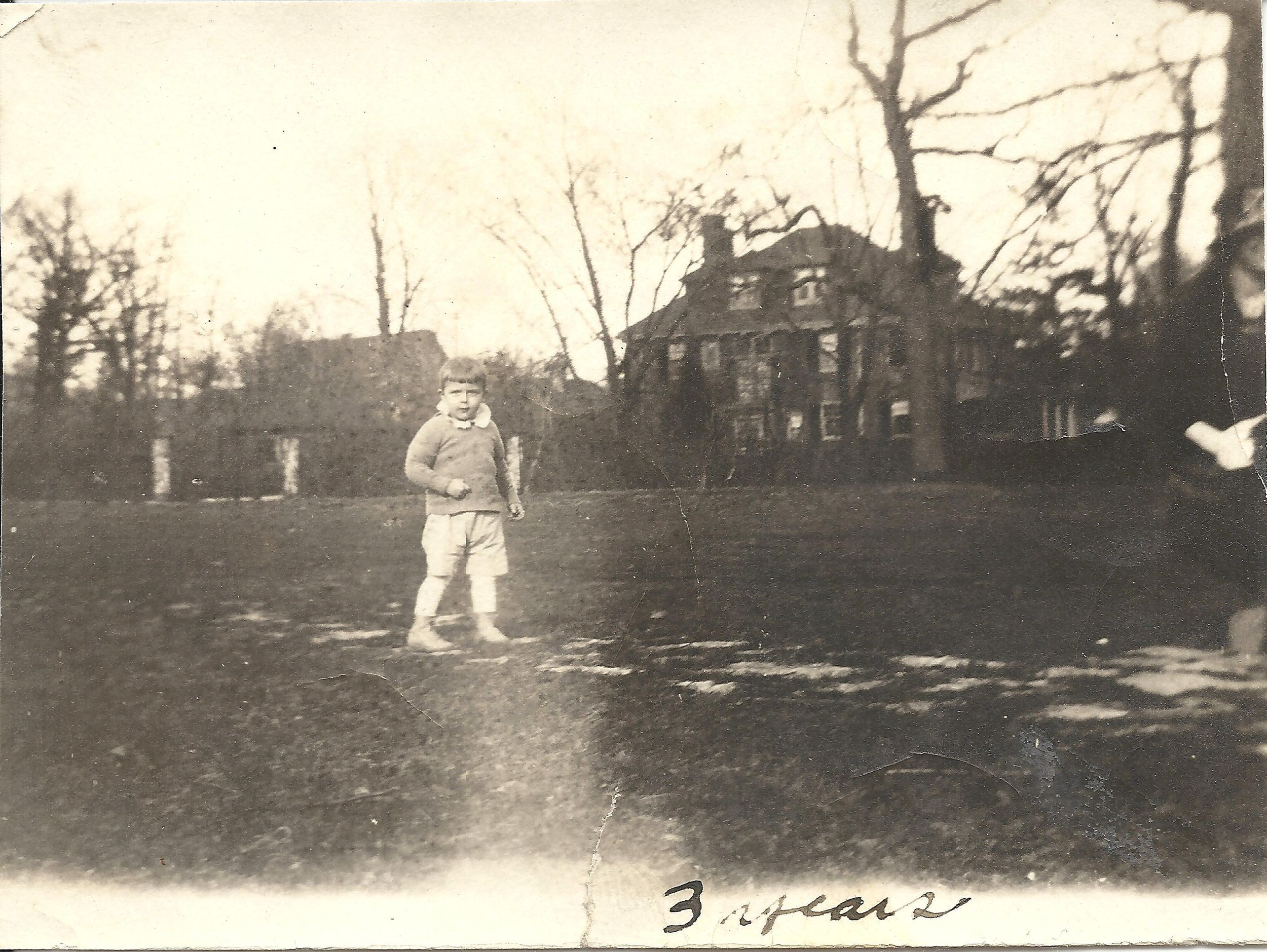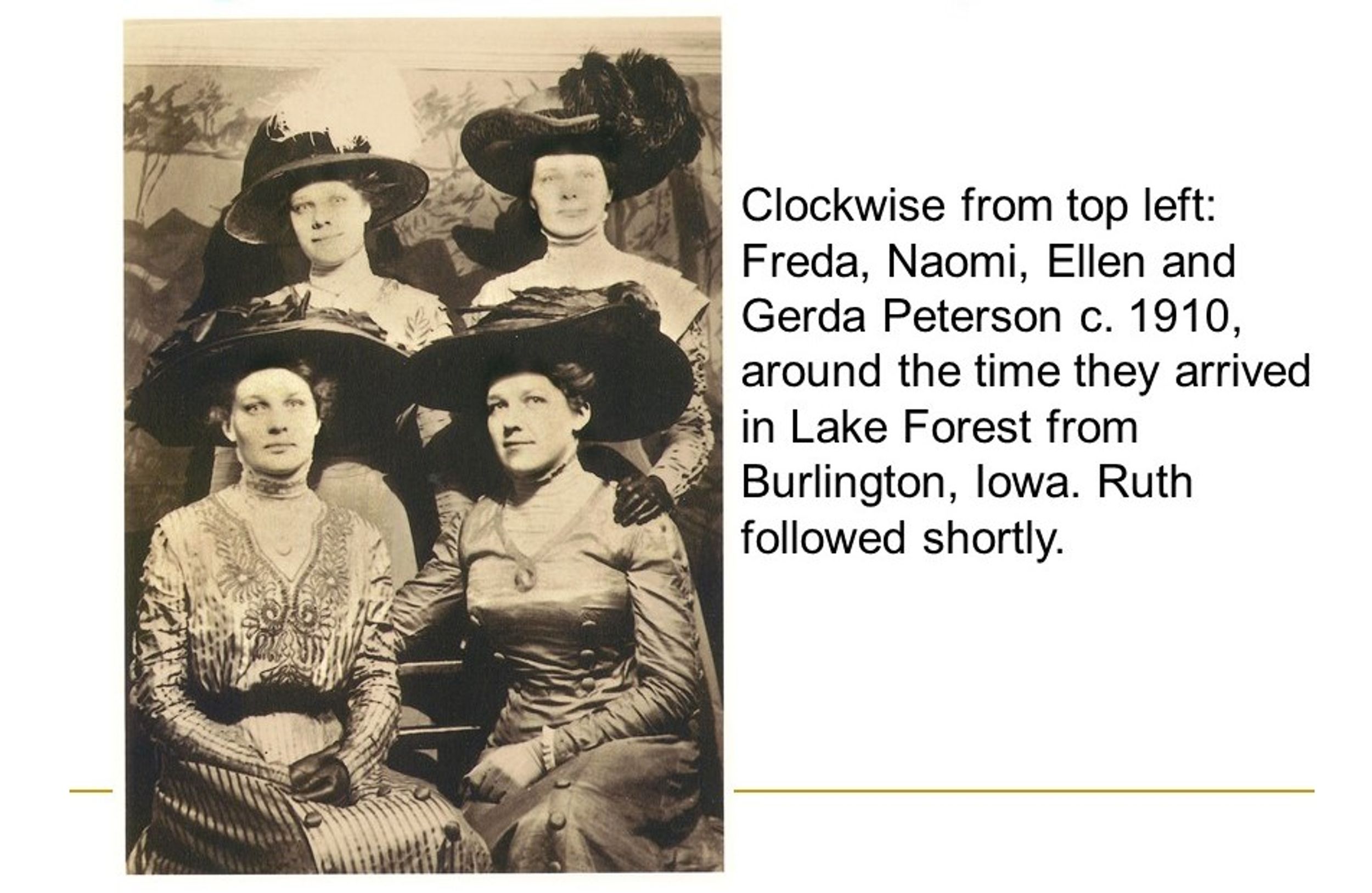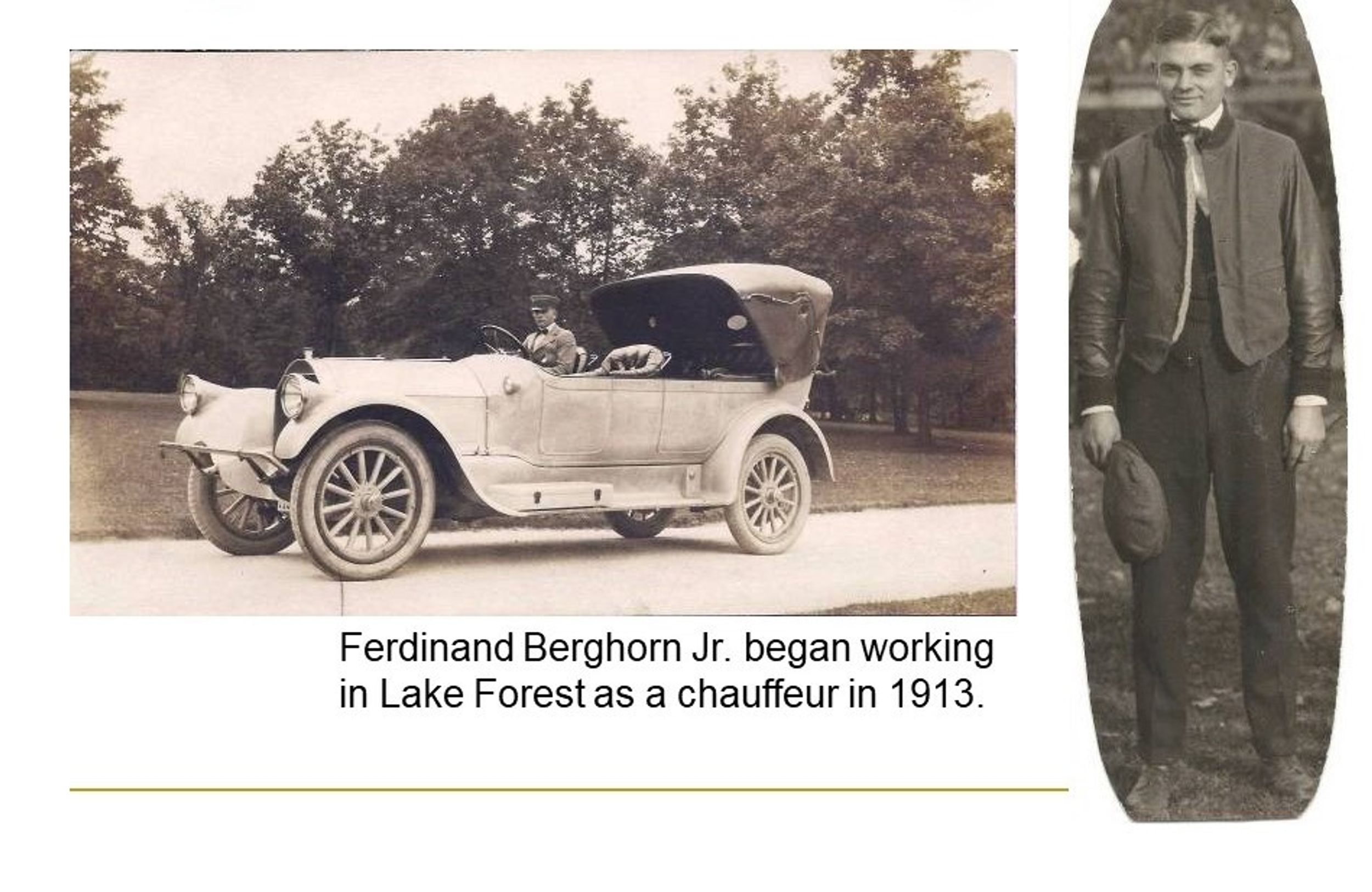Berghorn-Peterson Family

Fred Berghorn, 3 years, in Triangle Park, 1922-23. (Image courtesy Paula Berghorn Polito)

The Berghorn-Peterson family’s Lake Forest story begins around 1907, with the arrival in town of the Peterson sisters. The Peterson family had emigrated to the U.S. from Sweden in 1888, ultimately making their home in Burlington, Iowa. The five daughters, Gerda, Ellen, Freda, Naomi, and Ruth, all found their way, one by one, to Lake Forest between 1900 and 1910. Chicago was a natural destination for children of recent immigrants in the Midwest, and it was widely known that Lake Forest families often employed Swedish women as domestics.

The first of the Peterson family to arrive in Lake Forest were Gerda and Ellen, whose name appears in a 1908 town directory. Ellen worked for the Edward L. Baker family on Sheridan Road. Gerda had taken a position working as a domestic for the Captain Israel P. Rumsey family, whose home, The Evergreens, was on Deerpath. Upon her arrival she was picked up at the train station in a horse-drawn carriage by the Rumseys’ coachman, Alfred Braun. Braun resided on the second floor of the Rumseys’ carriage house, which, as you can see from the photograph, later became the Historical Society building. After many years of courting, Alfred Braun and Gerda Peterson were married in 1924.
The other Petersons soon followed their older sisters to Lake Forest. Freda and Naomi found positions next door to each other on Deerpath, working for the Frances Hewitt and William Kilman families (they were just down the street from Gerda). The youngest sister, Ruth, arrived in 1910, and began working as a waitress in the dining hall at Ferry Hall.

The Berghorn family arrived in the United States from Germany around the same time as the Petersons, but their journey west included stops in New Haven and Cincinnati before the family settled in Chicago in 1895. Ferdinand Berghorn Sr. was a blacksmith and horse shoer – his son Ferdinand Junior found work by 1912 as a delivery driver for Marshall Field in one of the company’s first motorized delivery trucks. By the next year Ferdinand Junior had translated these driving skills to a job in Lake Forest as a chauffeur, working for, among others, the Edgar Uihlein family.

Lake Forest Day, July 14, 1916
At the time, the Independent Order of the Vikings, a Swedish-American organization, held dances at the Anderson building at the corner of Deerpath and Western – the third floor was completely open then. The Peterson sisters would all attend those dances, and as it happens, three of them met their future husbands there. Ellen and Freda went on to marry a pair of brothers, Ander and John Rosquist, whom they met in 1915. Their younger sister Ruth had similar good luck – she first encountered Ferdinand Berghorn Jr. in the stairwell between the second and third floors of the Anderson building – they were married in 1916.

In 1916 Ferdinand Berghorn joined the Lake Forest police force as policeman #8, a position he retained into the 1920s. At the time the police officers used bicycles and motorcycles for their patrols. Historically it was a tricky time for law enforcement: with the increase in automobile use came a corresponding rise in speeding, accidents, and car thefts. A January 1917 issue of the Lake Forester describes a hit-and-run accident in Highland Park where the perpetrators ran into a car driven by Sergeant Potter of Fort Sheridan and then raced away to the north. The police in Lake Forest were notified of the crime via telephone. According to the account, “Policeman Berghorn spotted them on McKinley road but they refused to stop when ordered. At the bend in the road on the north edge of town Berghorn ran up beside them, caught hold of the machine, and put them under arrest. In trying to turn their machine they ran it into a tree and tipped over.” No one was hurt – Ferdinand Berghorn turned the criminals over to the Highland Park police.
Ferdinand Berghorn has another claim to fame. According to family lore, it was Ferdinand who, on the day of the Armistice in November 1918, rang the City Hall Bell so enthusiastically to signal the end of World War I that the bell broke, never to be heard from again. It was in service of the best sort of cause, of course.

Fred Berghorn was born in 1919 at Alice Home Hospital, delivered by Dr. Proxmire. That year his parents Ruth and Ferdinand moved into one of the new Market Square apartments, number 9.

When Fred was about 3 years old, the Lake Forest Sport Shop opened in Market Square. Ruth Berghorn was hired as a seamstress within the first year – she did customer alterations in the front room of the store manager’s apartment above the shop. In this instance location was everything – Ruth only had to step across the hall from their apartment to get to work. Fred remembers playing in the hallway and even helping his mother in the alterations room by picking up straight pins that fell on the floor.

Fred attended Halsey School for kindergarten through sixth grade, and then Gorton for seventh and eighth. The toy Packard in the photograph was a Christmas gift from his grandfather. Much later, Fred remembers learning to drive a larger sort of car with his father in South Park; as a police officer and chauffeur, Ferdinand was an ideal, if exacting, teacher.

Ruth Berghorn flourished in her position in the Sport Shop – she had the right temperament for the tasks, the ability to see good taste and style. In 1945 she was promoted and relocated to the Sport Shop in Hubbard Woods, where she was in charge of all fittings. Even after her retirement in 1959, her regular clientele continued to come to her for fittings and alterations – as her son Fred says, “They wouldn’t leave her alone.” She worked out of her home, remarking how over the years she saw customers bring back the same outfits again and again, as fashions changed and skirts became shorter.
Ferdinand Berghorn was similarly innovative in his job on the police force. He was often asked to keep an eye on empty homes when families went out of town for the summer. He devised a rather ingenious early “security system” to help him out by utilizing the city’s telephone exchange. He fixed up a series of strings in the vacant homes which were tied to the family telephone. If the strings were disturbed, they would signal the switchboard at the central telephone exchange, where the women on staff would in turn call the police. This system apparently saved a few homes from being robbed. It’s no wonder that Ferdinand’s son Fred went on to become an engineer.

Fred Berghorn first got his paper route when he was about 10 years old, around 1930. He delivered newspapers in the afternoon to the northwest quadrant of town, north of Westminster and east of the railroad tracks. Originally he would walk the route, carrying the newspapers in a wagon. Although a newspaper route seems like a fairly safe sort of job, there were hazards to be met and faced. In order to deliver the newspaper to the Brewster home, Fred had to walk through the gates and down a long path to the main house. In between was the Brewster pond, the domain of a very territorial swan, which remained forever unconvinced that the newspaper delivery boy was a friendly soul. To avoid the ambushing swan, Fred soon learned to leave his wagon at the gatehouse, race down the drive to the doorstep to deliver the paper, and then sneak back around the pond another way to outwit his attacker, who never did quite get him.
When Fred was 12, he worked out a deal with his parents, who financed the purchase of a bicycle, which Fred later paid back with his newspaper delivery earnings. After this, the swan never had a chance.
Fred had to give up his newspaper route when he reached high school, which he attended for the first two years at Highland Park, taking a special train for students on the North Shore Electric Line. The new Lake Forest High School opened when he was 16, and he graduated from there in 1937.

Fred Berghorn studied engineering at the University of Illinois. In the late 1930s, he met his future wife Madeline Serdar at a Sunday dance in Waukegan. The venue, called “The Rink” because on the weekdays it was a roller rink, played host to all sorts of big bands who stopped on their way between Chicago and Milwaukee. Fred and Madeline were married in 1942, shortly after Fred enlisted in the Navy at the outbreak of World War II.

After the war, Fred began working for Abbott in 1951. That same year, Fred, Madeline, and their two young children Paula and Greg moved into a new home on Greenview place that Fred designed himself – it remains his home to this day.

Although he has traveled all over the globe for Abbott, Fred Berghorn has always come back to Lake Forest, because even compared to the rest of the world, he says “this town beats all.” His gifts back to the community – from hundreds of volunteer hours at the Historical Society cataloguing architectural drawings to gifts of trees to provide shade to South Park and Triangle Park – will help ensure it remains that way.